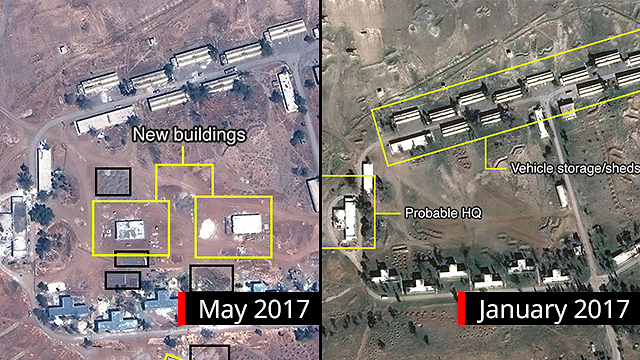
The Iranian base reportedly bombed by IAF
Photo: Digital Globe, McKenze intelligence Services ,BBC

Strike on Iranian base in Syria: Dealing with problem while it's still small
Analysis: Based on foreign reports, Israel brandished a yellow card to Iran with the leak of photos to the BCC three weeks ago of the base it was repurposing in al-Kiswah. As this warning was apparently ignored, it was followed by a red card in the form of the overnight strike on the base, which was attributed to the Israeli Air Force.
If there is truth to the many reports coming from opposition sources and Syrian regime media that the Israeli Air Force attacked an Iranian base
on the outskirts of Damascus early Saturday, Israel demonstrated to all players stirring the pot in Syria that its warnings are serious.
The attack overnight, it's safe to assume, was meant to validate the red lines Israel set to the Russians, the Americans, Bashar Assad's regime, Hezbollah and, of course, the Iranians.
The main message: Israel will not allow Iranian military presence of any kind in Syria. The fact the Russians and the Iranians ignored that message in talks Russian President Vladimir Putin had with the leaders of Iran and Turkey was likely what prompted Israel to further emphasize its message.
Based on reports in the international media, Israel has carried out a two-staged diplomatic operation, one was public in nature, while the other was military.
In the first stage three weeks ago, the BBC obtained aerial photos of an old Syrian military base, which is being demolished and rebuilt. The report noted the base, which is near the town of al-Kiswah, 15km southwest of Damascus, was supposed to house some 500 militia fighters operating in Syria on Iranian orders. The base is some 50km from the Golan Heights, and while it's not close enough to pose a direct threat to Israel, it certainly constitutes an important and clear component in Iran's military entrenchment in Syria.
The excuse the Iranians gave the Russians was that the Shiite militia fighters are supposed to protect the Assad regime in the Damascus area from rebel attempts to overthrow him. But there's no real doubt that this was supposed to be an Iranian base for all intents and purposes on Syrian soil.
The report about the base, it's possible to assume, was supposed to deter the Iranians and the Syrian regime from continuing the construction work there. But Iran and the Syrian army apparently continued the construction, and while the al-Kiswah base has yet to be populated, it is safe to assume there was already Iranian "representation" there at the time of the strike—a few Iranian military and Revolutionary Guards personnel, no more. It was apparently enough for Israel.
Russian Foreign Minister Sergei Lavrov recently said that Iranian (and Russian) military presence in Syria was "legitimate," because the Assad regime, which is the legal government, invited them.
But Jerusalem is not bound by Moscow's declarations. For Israel, as recent events and declarations make clear, permanent Iranian military presence in Syria is a red line that will not be accepted, even in its initial stages.
The obvious conclusion is that it's better to handle a problem when it is still small than to bomb this facility when it is fully manned and causing many casualties.
The publication of the aerial photos constituted a yellow penalty card, while the reported overnight attack was the red one.
Explosions and light flashes visible over Damascus
More to the point, it appears the strike on the Iranian facility near al-Kiswah, as well as the reported attack on a weapons cache meant for Hezbollah—also near Damascus—was not done from inside Syrian airspace, but from outside of it, using air-to-surface missiles.
This makes the reports of Syrian aerial defense attempts to intercept using anti-aircraft munitions appear credible, with these reports also supported by documentation. But contrary to the Syrian regime's claims, it does not appear the Israeli air-to-surface missiles were hit by the interception fire. The fighter jets were likely already on their way back to base when the Syrian anti-aircraft missiles were fired.
It is safe to assume the Syrians would try to improve their capabilities to thwart and respond to such situations, and that they will file a complaint with the UN Security Council. Regardless, it appears this attack is not going to lead to escalation in the near future.
The Iranian army chief visited Syria recently, and he apparently plans to provide the Syrians with better aerial defense systems, but at present the Assad regime has no significant measures to respond with. The Iranian commander warned at the time that "It is not acceptable for the Zionist regime to violate Syria anytime it wants." But it still remains to be seen whether the Iranians suffered any losses as a result of the attack, which could lead to possible retaliation.
And the Russians? They're staying out of it, in accordance with Kremlin policy that what happens between Israel and the Iranians and Syrians is none of their concern, unless it poses a direct threat to Russia's men, its presence and interest in Syria.


















